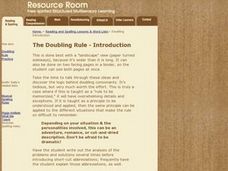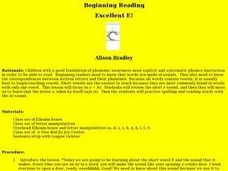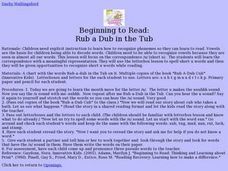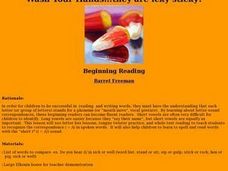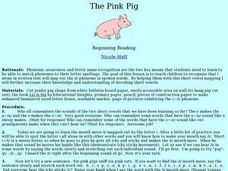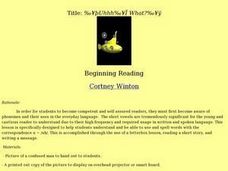Curated OER
The Doubling Rule
Students practice the rule for doubling the final consonant of a word when adding a suffix. Through guided practice and class discussion, they identify the spelling patterns that require letter doubling. Students practice doubling by...
Curated OER
Phonics lesson for "sh"
First graders identify words with the "sh" pattern. They participate in phonemic awareness, decoding, blending, spelling patterns, and dictation exercises. As the assessment portion of the lesson, they may write a story using words...
Curated OER
Excellent E!
Students explore the short /e/ sound. They practice making the sound and recite an 'e' tongue twister. They practice writing the letter e and use Elkonin letter boxes to spell e words. In groups, they read stories and identify short /e/...
Curated OER
Phonics lesson for -ar
First graders identify words associated with the -ar sound. They read sentences and compose a story that include words with the -ar sound. The assessment portion of instructional activity involves students in spelling words with the...
Curated OER
IIII---L-lll-ke---IIII-ke-and-M-IIII-ke
Students recognize the letter combination i_e by reading and spelling words with letter boxes in this instructional activity. They say a tongue twister which emphasizes the long /i/ silent /e/ combination. They then listen the story...
Curated OER
The Doubling Rule Practice
Students practice the rule for doubling the final consonant of a word when adding a suffix. Through guided practice and class discussion, they identify the spelling patterns that require letter doubling. Students practice doubling by...
Curated OER
Clifford Phonics Fun
Students develop phonemic awareness skills. They recognize consonant sound spellings and distinguish easily confused letter pairs. Students examine common short and long vowel sound spellings. They read stories containing high frequency...
Curated OER
Word Recognition
Students recognize and spell color and shape words. In this color and shape words lesson plan, students reinforce their vocabulary and spelling skills.
Curated OER
Letter Names
Students explore language arts by participating in a letter identification activity. In this word recognition lesson, students are shown a list of vocabulary terms which they practice reciting with their classmates. Students identify and...
Curated OER
A? Speak up, I can't hear you!
Students become phonemically aware of various sounds that make up written words. This instructional activity focuses on the vowel correspondence a_e=/A/. They decode the long a mouth moves in words as well as practice spelling the words...
Curated OER
Which Letter Comes First?
In this literacy worksheet, students find the pictures that correlate to the words and they also decide which letter to begin the spelling of each word.
Curated OER
Sorting words (four-block)
Third graders each receive an index card with a word written on it. They look for spelling patterns such as "oi." Students sort the cards according to spelling pattern, and practice spelling words with the snap, clap, slap hand motions.
Curated OER
Letter Recognition Flash Games for Kids
Students explore the alphabet by completing an on-line letter identification activity. In this phonetics lesson, students utilize the website www.literarycenter.net and listen to word sounds as they identify the spelling of the...
Curated OER
Listen Up!
Students explore the short /e/ sound. They practice writing the letter 'e' and making the short /e/ sound. They recite an 'e' tongue twister and practice finding the short /e/ sound in spoken words. They identify pictures of words...
Curated OER
Rub a Dub in the Tub
Students explore the short /u/ sound in this lesson. They use phonetic spelling to create words with the short /u/ sound using letter tiles. They then listen to the story "Rub-a-Dub Cub" and identify the short /u/ sound words they hear...
Curated OER
Wash Your Hands...they are icky sticky!
Students engage in an emergent literacy instructional activity that focuses on phonemic awareness and they practice corresponding the letter "i" to its long or short sound. This type of recognition has been found to be essential to...
Curated OER
Doc on Top
Students recognize the short /o/ sound in written and oral words in this lesson. They say a tongue twister which emphasizes words with the short /o/ sound. They then listen to the story "The Big Top" and identify the words in the story...
Curated OER
The Pink Pig
Students identify the short /i/ sound in spoken words and the letter symbol in this lesson. They say a tongue twister emphasizing words with the short /i/ sound. They then read the story "Liz is Six" and identify the words with the...
Curated OER
Uhhh..What?
Students identify and become competent and in reading the letter u, pronounced /uh/. They also use and spell words with the correspondance u = /uh/ by the use of a letterbox instructional activity, reading a short story, and writing a...
Curated OER
Jack the Fat Cat
Students recognize the short /a/ sound in written and spoken words in this lesson plan. They say a tongue twister which emphasizes words with the short /a/ sound. They then listen to the story "A Cat Nap" and identify the words in the...
Curated OER
Say Ahh!!
Students identify the short /o/ sound in spoken words, and recognize the letter symbol /o/. They say a tongue twister emphasizing words with the short /o/ sound. They then listen to the story "In the Big Top" and identify the words...
Curated OER
Let's Help the E Out!
Students explore the short /e/ sound. They practice making the sound, noticing how their mouths move to make the sound. They use letterboxes to spell and write 'e' words. They listen for the /e/ sound in a story and then write their own...
Curated OER
"Eddie the Excited Elephant"
First graders recognize each letter in the alphabet and the phoneme it makes. They recognize phonemes in spoken words and their corresponding letters or spelling maps and distinguish phonemes in their oral contexts.
Curated OER
Doc Says Open Up
Students recognize the short /o/ sound in spoken words in this lesson. They say a tongue twister with words emphasizing the short /o/ sound. They then listen the the book "Hop on Pop" by Dr. Suess, and identify the words they hear...


